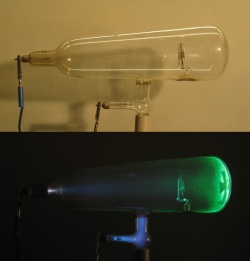Radiant Matter: Difference between revisions
Pablo Sender (talk | contribs) |
Pablo Sender (talk | contribs) |
||
| Line 10: | Line 10: | ||
Crookes thought the cathode rays consisted of a fourth state of matter where atoms were electrically charged. However, in 1897, Sir J. J. Thomson discovered they were not atoms, but a new particle (the first subatomic particle to be discovered) which was name "electron". Thus, Thomson proved that the cathode rays are streams of electrons. | Crookes thought the cathode rays consisted of a fourth state of matter where atoms were electrically charged. However, in 1897, Sir J. J. Thomson discovered they were not atoms, but a new particle (the first subatomic particle to be discovered) which was name "electron". Thus, Thomson proved that the cathode rays are streams of electrons. | ||
The Crookes tubes were used in dozens of historic experiments. For example, Wilhelm Röntgen discovered the X-rays in 1895, emanating from Crookes tubes. Eventually, these tubes were superseded by the electronic vacuum tubes, in whose development [[Thomas Edison]] played an important role. | |||
==Further reading== | ==Further reading== | ||
*[http://en.wikisource.org/wiki/Popular_Science_Monthly/Volume_16/November_1879/On_Radiant_Matter_I# On Radiant Matter by W. Crookes] at Wikisource | *[http://en.wikisource.org/wiki/Popular_Science_Monthly/Volume_16/November_1879/On_Radiant_Matter_I# On Radiant Matter by W. Crookes] at Wikisource | ||
Revision as of 18:27, 27 June 2012
Radiant Matter is the term used to describe what British physicist William Crookes believed was a fourth state of matter, in a time when the atom was thought to be a small solid ball, indivisible and without motion. Crookes's experimental work in this field was the foundation of discoveries which eventually changed the whole of chemistry and physics.
Crookes tubes
By the 1870s, the nature of electricity was a unknown and many experiments were done to determine what cathode rays were. Earlier experiments had been performed using tubes with a low vacuum, possessing two metal electrodes, one at either end. When a high voltage was applied between the electrodes, a glow that filled the tubes was observed.
William Crookes was able to generate a higher vacuum in tubes (known as "Crookes Tubes") and found out that as he pumped more air out of the tubes, they became totally dark, except for the anode end, where the glass of the tube itself began to glow. This showed that the cathode rays travel in straight lines from the cathode (negative) end to the anode (positive), causing fluorescence in objects upon which they impact and producing great heat.
Crookes thought the cathode rays consisted of a fourth state of matter where atoms were electrically charged. However, in 1897, Sir J. J. Thomson discovered they were not atoms, but a new particle (the first subatomic particle to be discovered) which was name "electron". Thus, Thomson proved that the cathode rays are streams of electrons.
The Crookes tubes were used in dozens of historic experiments. For example, Wilhelm Röntgen discovered the X-rays in 1895, emanating from Crookes tubes. Eventually, these tubes were superseded by the electronic vacuum tubes, in whose development Thomas Edison played an important role.
Further reading
- On Radiant Matter by W. Crookes at Wikisource
